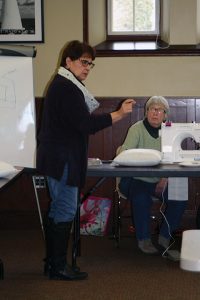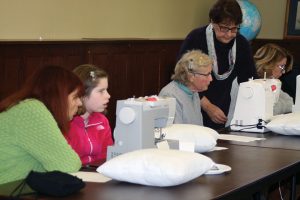The room was filled with anticipation as Bobbie Gaspar and Mary Chaplain introduced a group of 11 ladies and one younger lady to the joys of operating a sewing machine.
On March 18, the Mattapoisett Public Library sponsored a program on how to operate a sewing machine. Participants would learn the basics while making a covered pillow to take home. According to library staff member Robbin Smith, the program proved so popular that a second session is planned for May, although that one is also full to capacity. And while the goal of the two-hour program isn’t to impart mastery level skills, these ladies were looking forward to taking home a neatly covered pillow, one they had crafted themselves.
Being in the library always makes me feel like I need to do some research, so I did. Looking back at the history of the sewing machine, one finds a patchwork quilt (pun intended) of early efforts dating as far back as the mid-1700s. None of the earliest machines ever proved practical. A century later, with many failed efforts, the sewing machine had still proven to be an interesting concept only.
By 1840, Elias Howe had patented his version of a sewing machine. So had Isaac Singer. Subsequently, there was a long drawn-out legal battle between the two. Although these gentlemen never fully brought their own machines to mass production, by selling their patents to others, they lived out their remaining days as very wealthy men. The rest is history, as they say.
What all these men did do, however, was to appreciate the importance of finding a way to mechanize sewing in all its forms, from commercial to domestic. The impact on what was and still is primarily women’s work was profound.
Furthermore, the sewing machine was recognized during the industrial revolution as a critical invention.
Fast-forward a few centuries to 1969. I was enrolled in home economics classes at Wareham High School. Female students on one hand were being told “you’ve come a long way baby…” and on the other hand the importance of running a home with efficiency and grace. We girls who were deep in the throes of revolting against anything and everything that intimated “little woman” suffered through ‘home ec.’ Now I wish I had paid more attention.
As it turns out, home economics originated in the late 1800s as a science. The Huffington Post ran an article by Brie Dyas titled “Who Killed Home Ec? The Real Story Behind Its Demise,” on September 29, 2014.
In her article Dyas writes, “The creation of home ec is often attributed to Ellen Swallow Richards, a chemist and instructor at MIT, who paved the way for MIT’s Women’s Laboratory, which existed from 1876 to 1883 with a goal of advancing the scientific education of women at the Institution.
At the Women’s Laboratory, Richards turned her scientific attention to the study of how to make home life more efficient…Richards was very concerned to apply scientific principles to domestic topics – good nutrition, pure foods, proper clothing, physical fitness, sanitation, and efficient practices that would allow women more time for pursuits other than cooking and cleaning.”
While I thought home ec classes were ‘dumb,’ I did want to make that A-line skirt Miss Jackson was valiantly trying to teach us how to put together using a sewing machine.
As I recall, two things stand out the most from that experience: 1) bobbins are living demons whose ways of becoming tangled are too numerous to calculate, and 2) making a waistband for an A-line skirt truly is a science.
Suffice it to say, I somehow managed to create the skirt and even wore it a few times before I was informed how misshapen it was. Kids can be so cruel sometimes. But that exposure to the mysteries of operating a sewing machine left a gap in my fabric-crafting soul.
Deep in the recesses of the library, the ladies chatted quietly over the sewing machines lined up along the walls of the meeting room. They encouraged one another as Gaspar and Chaplain showed them how to thread a bobbin, my nemesis. These ladies were happily bonding over bobbins.
The instructors described various parts of the machine such as the pressure foot, throat plate, and feed dog. Then it was time to begin sewing the straight seams that would form the covers for their pillows.
Ann Marie Ridings, Mattapoisett, had received her first sewing machine many years ago from her father and through the years had acquired others that she used for quilting projects. And while a seasoned veteran of sewing machine operation, complete with puncture wounds, she shared, “I wanted to learn how to make a pillow.”
Patricia McPartland, Mattapoisett, said, “My mother could make clothing but I never learned.” On this day, seated beside the youngest lady in the group, she was taking the first steps towards learning how to use a sewing machine.
And what about that youngest participant?
Well, it turns out that she was one of the most experienced seamstresses in the room. “I’ve made clothes for my dolls, and I’ve made pillows,” said Brenna Carrier, 12 years old. She deftly produced a very straight seam indeed.
My take-aways are these: my desire to operate a sewing machine has been satisfied through vicarious participation and that operating one is both an art and a science. But moreover, the importance of passing on knowledge in the world that still needs home economics classes can’t be overstated. We should be putting down the iPhones and revving-up the sewing machines.
By Marilou Newell

